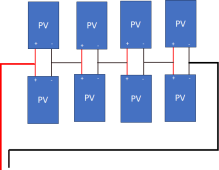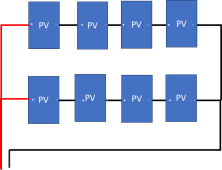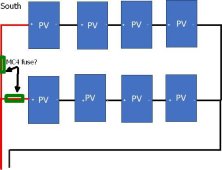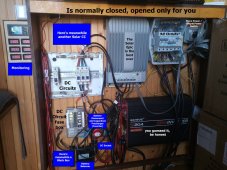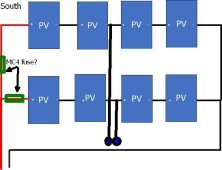Checkingout
New Member
- Joined
- Nov 7, 2022
- Messages
- 16
Hi everyone,
I've been waiting half a year to get all 8 panels delivered from amazon.
Got them on the tiny house roof now.
We have a few days of sun forecast (in rain I won't be on the roof, no).
I am wondering if my want-to-have array connection is doable like this? (image below)
It will be my second array, feeding my tiny house battery bank.
It would allow to stay within the 15A (wiring capacity) and below the 138V (MPPT CC's max is 138 OCV and 40A rated charge current).
b) I am also toying with the idea (wish) to wire the panels in such way that I could, alternatively, charge straight from DC the ebike battery I am going to receive soon (nominal 72V 50Ah, which comes with 87V 10A charger). For longevity, I want to limit charging voltage of this battery to 86.4V MAX (the 15A charge current, if so, would not be a problem at all, it can handle far more). Though, no one online (not here, not anywhere) seems to be successfully charging his EV battery straight from solar... (yet!). Maybe it's not sensible with EV....
Image of roof panel wiring idea:
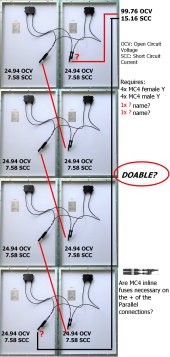
What do you think of this?
I've been waiting half a year to get all 8 panels delivered from amazon.
Got them on the tiny house roof now.
We have a few days of sun forecast (in rain I won't be on the roof, no).
I am wondering if my want-to-have array connection is doable like this? (image below)
It will be my second array, feeding my tiny house battery bank.
It would allow to stay within the 15A (wiring capacity) and below the 138V (MPPT CC's max is 138 OCV and 40A rated charge current).
b) I am also toying with the idea (wish) to wire the panels in such way that I could, alternatively, charge straight from DC the ebike battery I am going to receive soon (nominal 72V 50Ah, which comes with 87V 10A charger). For longevity, I want to limit charging voltage of this battery to 86.4V MAX (the 15A charge current, if so, would not be a problem at all, it can handle far more). Though, no one online (not here, not anywhere) seems to be successfully charging his EV battery straight from solar... (yet!). Maybe it's not sensible with EV....
Image of roof panel wiring idea:

What do you think of this?



